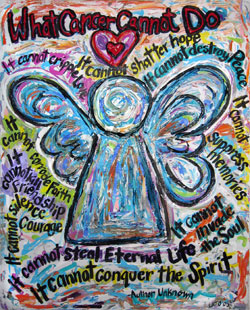
Image source: author unknown
General Description
Cancer can be defined as uncontrolled cell division. When cells in some areas of the body duplicate without control, the excess tissue that develops is called a tumor or neoplasm.
Tumors may be malignant and may spread (metastasize) to other parts of the body, or benign. Benign tumors are generally not harmful because they do not spread to other parts of the body. However, benign tumors may sometimes be removed to prevent disfigurement or interference with normal body function. (1)
Causes
Several factors may contribute to the loss of control of cell division. Agents which can can contribute to uncontrolled cell division are called carcinogens.
Chemical and other environmental factors (including lifestyle choices such as diet and smoking) are associated with an estimated 60 - 90% of all human cancers. Viruses may also initiate the cancer process. Ultimately, these mechanisms either directly or indirectly influence the cellular genetic program which control cell division.(1)
Much cancer research today is directed at understanding the genetic and biochemical mechanisms which cause the suppression of the normal cellular division process. Normally, if a cell becomes damaged by a carcinogen, there are mechanisms to eliminate these defective cells. However, when a cell becomes cancerous, many of these inherent mechanisms are also affected.(2)
At Risk
Both "lifestyle" and environmental factors play a major role in the risk for developing cancer. Lifestyle factors include diet, smoking, alcohol consumption and exposure to the sun. Environmental factors include air and water pollution.
The hydrocarbons in cigarette smoke are carcinogenic and it is not surprise that 90% of all lung cancer patients are or were heavy smokers.
Additionally, certain genetic predispositions may exist for certain cancers, but it is unclear how much is due to genetic susceptibitly and how much is due to similar lifestyles in related individuals. (1,2)
Prevention and Management
The best way to reduce the risk of cancer is to reduce or eliminate exposure to potential carcinogens. It is estimated that 80% of all cancers can be prevented by lifestyle changes such as diet, quitting smoking and reducing exposure to the sun.(1)
Diet may be a major factor in 30 to 40 percent of all cancers in men and for 60 percent of all cancers in women. Colon and breast cancer have a strong link to diet.(3,4)
Some of the foods we eat can contain cancer promoters. These include fat, alcohol and salt-cured and smoked foods.(2)
Many foods also contain compounds which help protect against cancer. There is a well established correlation between fruit and vegetable consumption and cancer risk. In particular, fruits and vegetables are sources of fiber, beta carotene, vitamin C, and other compounds associated with lower risk for cancer. However, individuals rarely consume enough of these to ward off potential carcinogens.(2,5)
Many plant-derived compounds (referred to as phytochemicals) show promise in both prevention and inhibition of the cancer process. Many of these phytochemicals operate as antioxidants and reduce the damage caused by free radicals. It is theorized that free radical damage to a cells genetic machinery may be one of the mechanisms of cancer promotion.(3,6,7)
These phytochemicals include allyl sulfides (onions, garlic, leeks, chives), indoles and isothiocyanates (cruciferous vegetables), isoflavones (soybeans), phenolic acids (tomatoes, citrus fruits, carrots), polyphenols (green tea, grapes, wine), saponins (beans and legumes) and terpenes (cherries, citrus fruit peels).
Eating a variety of vegetables and fruits is more important than concentrating on particular kinds to get the full gamut of phytochemicals found in nature. The following guidelines are recommended by the American Institute of Cancer Research (AICR):
1) eat more grains,
2) eat a variety of vegetables,
3) eat more fruit,
4) season with herbs and spices instead of salt,
5) decrease portions sizes of meat fish and poultry,
6) explore new foods and new recipes.
Additional Information
Disclaimer: These websites, addresses and/or phone numbers are provided for information purposes only. USANA, Inc. makes no claim, actual or implied, regarding the content or validity of the information obtained from these outside sources.
American Institute of Cancer Research. 1759 R Street N.W., Washington, DC 20069, 1-800-843-8114
Abstracts
Ames BN, Gold LS, Willett WC. The causes and prevention of cancer. Proc Natl Acad Sci U S A 1995 Jun 6;92(12):5258-65. Epidemiological evidence indicates that avoidance of smoking, increased consumption of fruits and vegetables, and control of infections will have a major effect on reducing rates of cancer. Other factors include avoidance of intense sun exposure, increases in physical activity, and reduction of alcohol consumption and possibly red meat. A substantial reduction in breast cancer is likely to require modification of sex hormone levels, and development of practical methods for doing so is a high research priority. Resolution of the potential protective roles of specific antioxidants and other constituents of fruits and vegetables deserves major attention. Mechanistic studies of carcinogenesis indicate an important role of endogenous oxidative damage to DNA that is balanced by elaborate defense and repair processes. Also key is the rate of cell division, which is influenced by hormones, growth, cytotoxicity, and inflammation, as this determines the probability of converting DNA lesions to mutations. These mechanisms may underlie many epidemiologic observations.
References
1 Ruddon, RW. Cancer Biology. Oxford University Press. 1995.
2 World Cancer Research Fund/American Institute for Cancer Research. Food, Nutrition and the Prevention of Cancer: a global perspective. Banta Book Group, Menasha, WI. 1997.
3 Bidlack WR, Interrelationships of food, nutrition, diet and health: the National Association of State Universities and Land Grant Colleges White Paper. J Am Coll Nutr 1996 Oct;15(5):422-33
4 Bland JS. Phytonutrition, phytotherapy, and phytopharmacology. Altern Ther Health Med 1996 Nov;2(6):73-6
5 Fraser D. Nutrition and cancer: epidemiological aspects. Public Health Rev 1996;24(2):113-21
6 Halliwell B. Oxidative stress, nutrition and health. Experimental strategies for optimization of nutritional antioxidant intake in humans. Free Radic Res 1996 Jul;25(1):57-74
7 Cassileth BR and Chapman CC. Alternative cancer medicine: a ten-year update. Cancer Invest 1996;14(4):396-404
Source